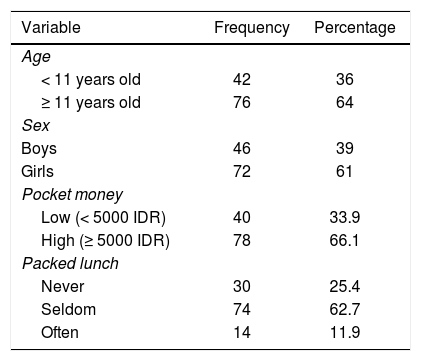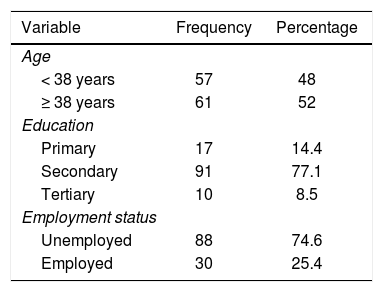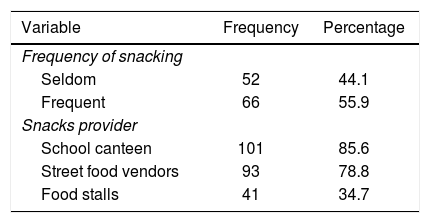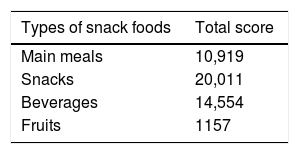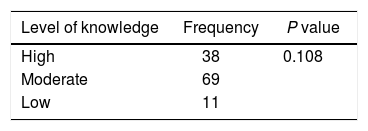Eating behavior of school-aged children was dominated by street foods. The aim of the present study was to examine the relationship between maternal knowledge of balanced nutritional guidelines and snack food selection by school-aged children during school hours. This also aims to describe each demographic data and level of mother's knowledge.
MethodThis study conducted a descriptive correlational design. The participants were selected using simple random sampling technique, consisting of 4th and 5th grade elementary school children and their mothers in SDN Tugu 4, Depok City, Indonesia. Demographic data were also taken for each. The instruments used the Food Frequency Questionnaire and questions about the balanced nutritional guidelines. Statistical analysis conducted a univariate (descriptive) and bivariate (relationship) analysis. Bivariate analysis used independent t test and ANOVA test, using (P value < 0.05) to indicate a significant relationship.
ResultsA total of 118 elementary students and their mothers participated. The results showed that there was no significant relationship between maternal knowledge of balanced nutritional guidelines and snack food behavior by children during school hours (P = 0.108). Level of knowledge of the mothers on balance nutritional guidelines was dominantly moderate (58.4%).
ConclusionsParents no longer became a major factor influencing the child's diet. Peers have more influence on the diet of children this age. This study points to the importance of education on healthy and safe snack foods for school-aged children in collaboration with peers, parents, teachers, and food vendors at school.
The risk of nutritional problems, such as malnutrition, is high among school-aged children, who are a vulnerable group1. This period begins when a child enters elementary school aged 6 years and continues until the child reaches 12 years2. Outside the home, the eating habits of many school children are often dominated by snack foods3. The Indonesia Drug and Food Surveillance Board4 defines snack food as fast food in the form of food and beverages processed by food manufacturers for sale and/or served as ready-to-eat meals and sold to the public. Snack food is classified into main meals, snacks, beverages, and fruits4,5.
According to surveillance data on snack food consumed by school children in 2007, 45% of school snack foods of PJAS (Pangan Jajanan Anak Sekolah) contained harmful chemicals (formalin, borax, and rhodamine), artificial food substances (sweeteners and preservatives) in excess of safe limits, and microbiological contamination (Escherichia coli)4. It also reported that food poisoning outbreaks in elementary schools were among the highest across various levels of education. A survey of 40 Islamic elementary schools in De-pok in 2012 reported that 52% of food stuffs and 60% of drinks sold in schools contained bacteria, 4% of street food contained formalin, and 10% of food stuffs contained artificial sweeteners6.
Food consumption is the result of motivation (needs, drives, and desires), which is determined by a variety of cognitive processes, including perception, memory, thought, and decision to act7. Food preferences arise as a result of the frequency of exposure8. The more often a food is perceived, the possibility that the food is preferred, and the more often the food is selected.
Mothers play a pivotal role in the nutritional needs of children. Previous research suggested that socioeconomic status and parental care significantly contributed to shaping school children's behaviors, including their knowledge, attitudes, and practices9. However, previous research has not confirmed any relationship between maternal knowledge of correct nutrition and snack food purchase and consumption by children at school, specifically knowledge of balanced nutritional guidelines: known as PUGS (Pedoman Umum Gizi Seimbang) in Indonesia. The guidelines are an update of the older 4 Sehat 5 Sempurna and contain 13 messages about balanced nutrition9. These messages emphasize the principles of diversity of food and portion size, with portions varying according to the age, sex, and level of activity of the individual.
The revised guidelines emphasize the pivotal role played by the mother as the primary care giver. Dangers posed by the consumption of snack foods at school highlight the need for studies involving elementary school students and their mothers. Such studies can provide a scientific basis to identity prompt and effective evidence-based interventions to improve the nutritional status of school children.
The aim of the present study was to determine whether there was a significant relationship between maternal knowledge of current nutrition paradigms and children's snack food selection at school.
MethodDesignCorrelational descriptive design using a cross-sectional approach to describe the relationship between the variables studied10.
Population and study settingThe study population consisted of students in SDN 4 Tugu, Cimanggis, Depok City. One hundred-eighteen participants (students in 4th and 5th grade and their mothers) were selected using a simple random sampling method. The inclusion criteria were: a) elementary students living with their mother, and b) a willingness on the part of the mother and child to take part in the study. All the participants provided written-informed consent.
VariablesIn this study, the dependent variable was the behavior of school-aged children in terms of school snack food selection and preferences. The independent variable was the mother's knowledge of balanced nutritional guidelines (PUGS).
Data collectionThe research instruments used was the FFQ (Food Frequency Questionnaire) form, which contains 43 items on school snack foods11. This instrument was used to measure children food frequency and preference. The questionnaire for the mothers consisted of demographic data (age, education level, and employment status) and 24 questions about the balanced nutritional guidelines (true or false choices). The questionnaire for the students consisted of demographic data (age and sex), provision of pocket money or a packed lunch, and consumption of snacks (snack frequency and snack locations).
Data analysis: SPSS 15Univariate analysis (descriptive) and bivariate (relationship). A descriptive analysis was conducted to describe the proportions and mean of each variable (students' characteristics, consumption of snacks, mothers' characteristics, mothers' knowledge of balanced nutritional guidelines, and school snack food selection scores). A bivariate data was analyzed using t test and one-way analysis of variance test were performed to determine the relationship with a P value < 0.05 (significant statistically).
Ethical aspectsOfficial permission letter from author's institution was released and addressed to the population institution before collecting data. This has been through supervisor review and institution approval. Informed consent was required prior to data collection. All participants were explicitly explained the aim and the process of collecting. The authors declare that there are no ethical, moral, and financial violation and conflicts throughout the study.
ResultsThe characteristics of the students are described in Table 1. Most of the students were > 11 years (n = 76; 64%). The remaining students (n = 42; 6%) were < 11 years. In terms of the sex distribution, girls (n = 72; 61%) dominated the sample. Data on pocket money indicated that most of the students (n = 78; 66.1%) were in the high category (> 5000 IDR or US $ 0.37). The majority of the students (n = 74; 62.7%) rarely brought a packed lunch prepared by their mothers to school.
Table 2 shows the characteristics of the mothers and demographic data, including age, education, and employment status. The age distribution showed that most mothers (n = 61; 52%) were > 38 years. Most mothers (n = 91; 77.1%) had a secondary education (junior high school). The mothers' employment status varied, with more than half the mothers (n = 88; 74.6%) not working.
As shown in Table 3, the frequency of snacking among most students (n = 66; 55.9%) was high. In terms of the location of snack providers, the main site was the school canteen, with 101 (85.65%) students purchasing snacks from the canteen, followed by street vendors (n = 93; 78.8%), and food stalls or warung (n = 41; 34.7%).
As shown in Table 4, the types of school snack foods most frequently consumed were toast (68.6%), batagor (87; 3%), somay (89%), fried rice (79.7%), and fried noodles/noodle stew (84.7%). In terms of snack food categories, many students (n = 76; 64.5%) consumed fried foods, sausages fried/ grilled (n = 69; 58.5%), cimol (n = 96; 81.4%), chocolates (n = 88; 74.6%), biscuits/wafers (n = 97; 82.2%), chips (n = 103; 87.3°%), candy (n = 101; 85.6°%), and cilok (n = 76; 64.4°%). With regard to beverage consumption, many students consumed milk/iced milk (n = 84; 71.2%), iced tea (n = 63; 53.4%), Pop ice (n = 84; 7%), ice-cream (n = 89; 75.4%), ready-to-drink beverages (n = 105; 89%), and powdered drinks ready for brewing (n = 107; 90.7%). Only 38 (32.1%) of the 118 children consumed fruit at school.
Table 5 shows the relationship between the mother's knowledge of balanced nutritional guidelines and snack food selection by children at school. There was no significant relationship between the mother's knowledge of these guidelines and snack food selection at school, with P = 0.108 (P > a).
DiscussionThis research showed that snack food selection by children at school was not related to their mothers' level of knowledge of balanced nutritional guidelines. The result was consistent with development theory on characteristics of school-aged children as compared with those of preschool-aged children2. Elementary schoolchildren have more independence in selecting snacks at school, whereas preschool-aged children are under the control of guardians and are not permitted to make their own food choices8.
Mothers' knowledge of nutritional foods is important, as they play significant roles in food provision for school-aged children. In the present study, the majority of the mothers were older than 38 years. Although this should mean that maturity in thinking is better, it does not guarantee the ability to direct the child in the selection of snacks at school.
According to Crockett and Sims12, teachers and other people in school (peers, school canteen staffs, and school staffs) in school play a more significant role in shaping the eating behaviors of school-aged children than mothers13. Other research found that in addition to peers, access to snacks at school, billboard food advertising, and food advertisements on TV had a great influence on the diets of school-aged children11.
The finding of increased snack food consumption in the present sample of 4th- and 5th-grade elementary students was in accordance with that of Cooke and Wardle14, who found that the quantity of snack consumption increased with the age of the child14. Cognitively, children progress from making judgments based on what they see (perceptual reasoning) to judgments based on reasoning (conceptual thinking2). The time spent in school contributes to children's exposure to food snacks15. In addition to snack food availability at school, the personal characteristics of the child indirectly contribute to school snack consumption behav-ior16. The provision of safe and healthy snacks in school would reduce the risks posed by unhealthy snacks.
In the absence of parental supervision and the ability to select their own food, schoolchildren are likely to turn to a variety of snacks. Unlike teenagers, school children are unlikely to be health conscious or to pay much attention to calorie counts or nutrition contents of foods. As reported previously, self-control or self-regulation is important in the construction of snack food intake17. However, school-aged children look to their peers when it comes to making behavioral choices13.
This study points to the need for a collaborative intervention and peer support in order to improve the quality of food preference and selection by school-aged children. Such a collaborative intervention should involve students, teachers, parents, and food vendors and aim to improve nutritional knowledge and skills in preparing, cooking, and selecting healthy and safe snack foods. Previous research confirmed that nutritional interventions involving mothers and children improved self-regulation among children as regards food selection and increased the mother's self-efficacy in providing meals at home11.
Based on the results of this study, there was no significant relationship between the level of mothers' knowledge of balanced nutrition guidelines and snack food selection behavior of school-aged children. School-aged children are more independent than preschool children with regards food selection and diet, particularly at school. Teachers, peers, parents, and food vendors can influence students, and the school environment can be modified to support healthy and safe snack food consumption.
The findings of the present study could aid the development of a collaborative school nutrition intervention involving students, teachers, parents, food vendors, and peers. Further research is needed using multivariate analysis to identify factors that predispose school-aged children to snacking habits and develop a module to promote balanced nutrition and food safety among school-aged children. Such an experimental research should be necessarily undertaken. It would involve family, teachers, and peers that are important to create an atmosphere conducive to healthy eating behavior among school-aged children at school.
AcknowledgmentI utterly say sincere thanks to all 4th and 5th grade students of SDN Tugu 4 Depok for your esteem support as the participants of this research, as well as the mothers and school staffs. Another valuable gratitude I address to my undergraduate research supervisor, Mr. Ns. Sukihananto, S.Kp., M. Kep., for your motivation and precious advice along the process. And more important, to the library of the Faculty of Public Health Universitas Indonesia. Sincere thanks also dedicated to my beloved parents, sisters, friends, and all who have provided immeasurable support during this research.





